


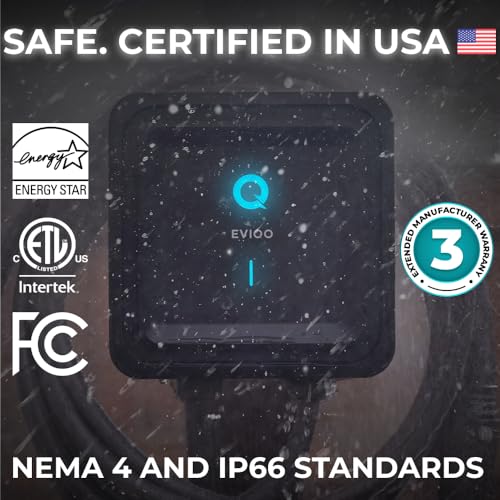
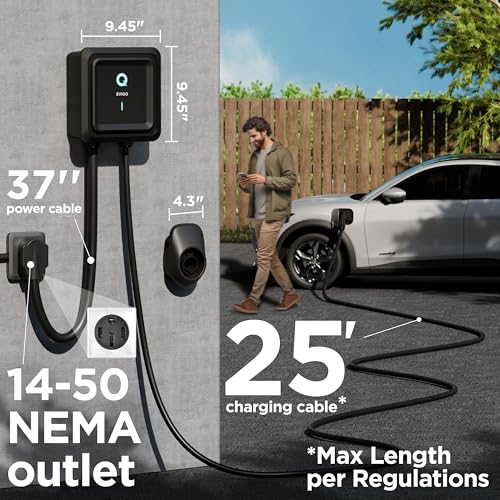
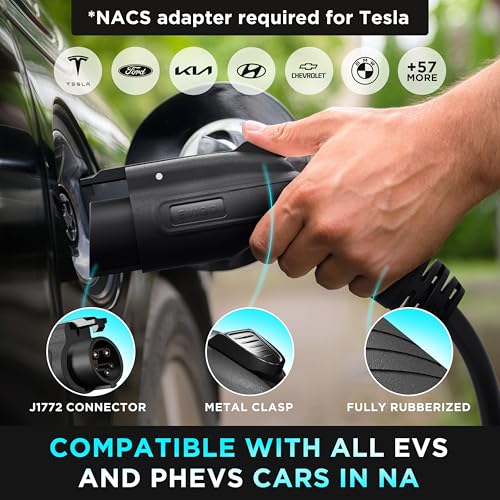
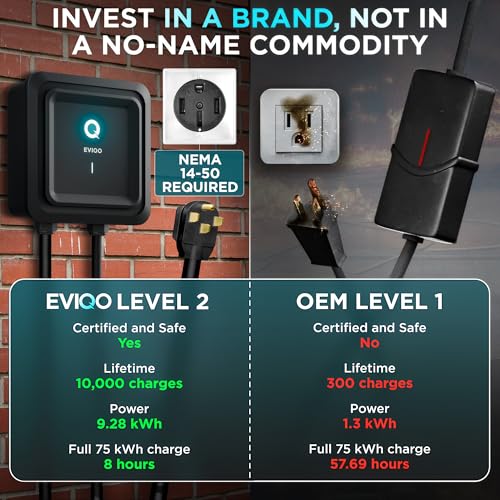
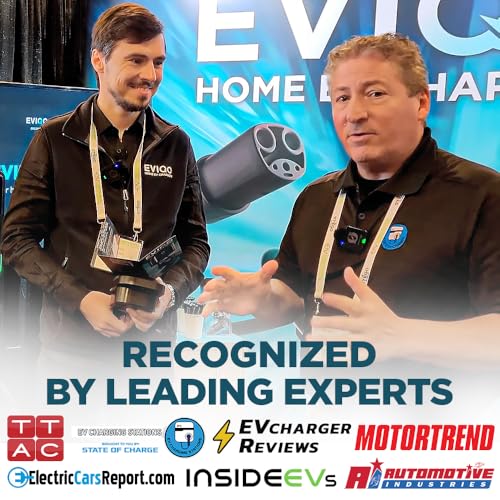
July 2, 2025 ordered the EVIQO from AMAZON and got it July 5.The EVIQO (albeit being the only one that I have experience with) is the easier to install/use charger. The only way that I would be easier would be for the EVIQO manufacturer to come to my house install and get it going for me.I ordered the plug in version thinking that it will be easier to just plug in, but after I got it I decided to just hardwire it to have the option later to charge at full 48A. I got prices for installers to come over and do the install. The install is an easy run, unfinished basement, no ceiling, measured 42ft from the box (south side of house) to the west side of the house (driveway), drill a hole through the siding, mount electrical box and mount charger/plug holder. The first quote through my electric company DTE (Detroit Energy, Michigan) and two other electricians found in the local Facebook neighborhood. The one through DTE wanted after just a video call $2000, another one $1500 plus permit $100 to $150 and the third one just gave me a starting price of $1000, all of them blamed wiring prices and did not trust my measurement of 50ft (I added extra just to be safe) and kept telling me that if it is more that they would have to buy a lot of wire and that the cost was $400 to $500. Decided that this is too much of a hassle so I just took a deep breath and decided to do it myself. I went to the hardware store, big box, bought 50ft each Red and Black 6AWG THHN, 50ft Green 10AWG for the Ground, no need for the Neutral wire, a 60A 2-pole circuit breaker, no need for AFCI, it is built in the charger, a waterproof box for an outlet, the wires for the charger just go in and out of this box. Total Cost in materials $256 and got like 6ft of wire left of each. It took me a while just because I like to overthink things and never done it before. Started at around 11AM. First removed the plug from the charger and connected the wires to the charger (I soldered the wire to the terminals, supplied by the manufacturer, to make a better connection rather than rely on the crimp), then went outside and decided where to mount it and measured multiple times, inside and outside, inside and out, overthinking it, and bit the bullet and started drilling. The wires have to be connected to the charger before you start the installation. So with all the holes drilled for mounting the charger, for the wire to go into the house and for the electrical box I fed the wire from the outside and mounted the charger then started working on the electrical box, it was kind of hard since from the outlet box to the charger it is only around 8in so feeding the 3 thick wires through a 3/4in conduit was a bit hard. I stopped around 6pm, but by the end of the day everything was mounted outside. The following day started around 10am ran the wires to the electrical panel, attached them to the basement joists and connected to the new circuit breaker that I just bought and connected it to the panel, was done by 1pm, for a total of ~10 hrs. Not bad considering that I don’t do this for a living and don’t have all the tools, just a drill, a hammer and screwdriver. With all these connections done now it time for the app. Downloaded the app, setup the account, powered the charger up and within 3 minutes everything was up and running and charging the vehicle. Even though I hardwired the charger I decided to keep the selector switch at 40A (default for the plug in unit that I ordered). I figured the extra 8A (from 40A to 48A) just cut the charging time by 1.5hr. While charging the vehicle the wires and circuit breaker got barely warm. Charged the car from 70% to 80%, recommended by car manufacturer, in 1hr and based on my rate cost me $1.31 for close to 40 miles of driving which would have cost us in the car we traded in close to $4.You can argue that it took me 10+hrs., well it was not constant work, taking breaks for lunch and thinking, and that my time maybe more valuable, but the satisfaction of doing it and not overpaying makes it worth it. Even if you account for 11hrs @ $100 plus materials it comes to $1360, still less than the installers. And wouldn’t it be nice to make $100 and hour.I contacted the manufacturer to ask about the lights, they are bright, I was wondering if they can be dimmed or turned off at night when the unit is not in use.This is the reply:"Regarding the LED indicators: unfortunately, their brightness is regulated—especially in Southern states—so they must remain clearly visible even in bright sunlight. We understand this might be noticeable at night, and we truly hope it hasn’t affected your overall impression of EVIQO.If you'd prefer to completely turn off the unit when not in use, a simple option is to unplug it (if using a plug-in model) or flip the breaker connected to the charger."At least they replied which is nice to know that they are there, but I do not live in a southern state so I should not be bound by some weird requirement in the south, they have my zip code so based on that you should be allowed to dim or turn off the lights. It is just software. Their recommendation to unplug it or turn it off at the breaker when not in use, is not an acceptable answer from my point of view. I can live with the lights but I would prefer to dim them.
I own a Chevrolet Bolt 2019 model. When I bought this car, initially, I used the standard Level 1 charger that was supplied with the car. Since the performance of this charger was unsatisfactory, in October 2019, I bought a JuiceBox 40 Smart EV charging station (Level 2) with Wi-Fi. It turned out to be anything but "smart" but that would be a different story/review.On January 3, 2024, when I walked out into the garage, JuiceBox welcomed me with beeping noises. After a little bit of diagnostics myself, I called ENEL (manufacturer) customer service. Here, I would like to state that ENEL customer service is among the best. The customer service representative had me repeat a few of the diagnostic steps and declared the unit dead. The device used a mechanical relay which had a known issue. Since I was among their earliest customers and the unit had a known issue, I was offered a replacement newer model at $100 discount. Don't ask me why I was never informed of the "known" issue and a replacement sent to me when the "issue" was discovered! In any case, it was a complicated process (digging up old receipts, ENEL back-end system failures, etc.) but a replacement was ordered the same day (01/03/2024). Given my situation, I was promised a priority overnight shipment. Lo and behold, it is 01/09/2024, there is still no sign of a replacement. Every time I called, I was told the replacement was ready for shipment and waiting for the "carrier" to pick it up! Great customer service can go only so far if the rest of the company functions are not supportive enough. I knew it was time to look for an alternative and canceled my JuiceBox upgrade order.I am a retired computer scientist and engineer, and it is my nature to research everything about my choices before deciding to buy a specific product. Accordingly, I made a list of top Level 2 EV chargers and started reading installation instructions, user guides, expert reviews, and user reviews. After all the hard work, my choice was narrowed down to: Tesla or EVIQO. Given my recent decision to boycott all Musk owned businesses, the final decision was easy. However, what sealed the deal was when I called EVIQO customer service with a question on a Sunday and, guess who answered the call, a co-founder of the company! My question was satisfactorily answered, and I ordered my charger.The unit was received promptly, and I installed it without a hassle. It has been in operation for more than 6 weeks now and is working to my satisfaction charging the Bolt after midnight when the rates are the cheapest. In fact, the installation and setup were a breeze compared to JuiceBox. Please note that I ordered a pluggable unit, and I already had the requisite 240V (NEMA 14-50) outlet in the garage. Based on my experience, all parts are high quality and, in some cases, better than the competitors. In my humble opinion, EVIQO charger is a superior product and I wholeheartedly recommend it.I did run into one non-technical issue - I am a member of the SmartCharge New York (SCNY) program which offers rebates for responsible use of EV charging. While JuiceBox was a SCNY-certified charger, unfortunately, EVIQO is not. I have requested SCNY to certify the EVIQO device but don't know how long the process is. It is my fault that I did not investigate this beforehand and stand to lose about $500 every year if the program continues and the EVIQO device remains unsupported.Given my background, I do have a few suggestions for improvements, however, I am not an electrical engineer and don't know how feasible some of the suggestions are. I compared the installation of EVIQO to installing and setting up the Starlink service. My experience with Starlink was the absolute best even though I had to cancel the service because of distaste for Mr. Musk's line of thinking. My Starlink unit was shipped with everything a homeowner may need for the installation, even a small piece of well-designed plastic stick to snake a wire through a 6-9" thick wall. Here are some of the salient corrections and/or suggested enhancements:1, Page 10 mentions needing a level and a stud finder, however, I did not see any mention of these two tools again in the installation instructions.2. I am a tool nut and already own a stud finder. However, I was unable to find a suitable "studded" location for the installation. The supplied M6 Hexagonal Expansion screws are not suitable for drywall installation. I bought and used heavy-duty anchors (and compatible screws) from the local hardware store. I wish such anchors were included with the product.3. Page 15 mentions 0.31" (8 mm) drill bit, which would be 5/16" for us retarded Americans.4. I wish there were a way to separate and, independently, configure input and output power cable to/from the charger. Please look at the picture, I was forced to cross the input and output cables because of the location of the outlet which made part of the installation process a little difficult.5. For better or worse, most garages are storage space for junk and mine is no different. While the charger unit is inside, the car is outside the garage. This makes routing the output cable under the garage door a challenge! If I had my wish, I would have drilled a nice clean hole through the garage wall, mounted an additional holster outside, routed the output cable through the hole, and plugged it into the charger. Imagine if the charger had twist-lock receptacles for input and output cable ports (top and bottom instead of the current both at the bottom)! This would help with cable crossing issues and help with keeping the two cables independently routable.6. There is no good reason to justify the annoyingly blinking green LED indicating waiting to start. Since I use scheduled charging, this is the most common situation in my case. I would recommend dim green for "Ready to start" and brighter green for "Waiting to start".As far as the mobile application to control the EVIQO, it is better than the most. It has been my life experience; software is always an afterthought for hardware manufacturers. However, that is not the case EVIQO, although I did have some usability challenges because the application is designed to be compatible with Android and iOS (the one I am used to). It will be helpful to simplify the functionality related to inputting utility rate structure and usage of this information with scheduled charging times.
The EVIQO Level 2 EV Charger offers fast, flexible home charging with a 48-amp capacity and 240V output. It also features a 25 foot charging cable and an easy-to-use app. Unlike the ChargePoint Home Flex, it can be used as a plug-in (40A) or hardwired (48A) unit. If you choose the NEMA 14-50 plug-in option, you'll have an easier installation process than you would with a hardwired option — although the trade-off is slightly slower charging.
50 EV Charger: Plug ev chargers for home level 2 into a NEMA 14-50 outlet without electrician help. Delivers up to 40A output (9.6 kWh). For full 48A charging of ev car charger (11.5 kWh), a hardwired installation on a 60A circuit is required
UL, ETL, FCC & Energy Star approved for safety and efficiency, making it a trusted level 2 home ev charger. Its NEMA 4/IP66 housing withstands rain, snow, and heat, ensuring durability from a reliable ev car charger level 2
Fi & App Control: Set charging schedules, track usage and update firmware remotely for full control of your ev level 2 charger. Designed with an intuitive app, it provides features that enhance the daily use of your ev home charger level 2
Level 2 EV charger J1772 connector equipped and supports all EVs and PHEVs in NA. With ev charger level 2 performance, it powers Chevy, Ford, Hyundai, Kia and works as a level 2 ev charger Tesla with adapter (not included)
Minutes Installation: Quick wall mount setup with included kit, no electrician required, making it simple to start using your ev wall charger level right away